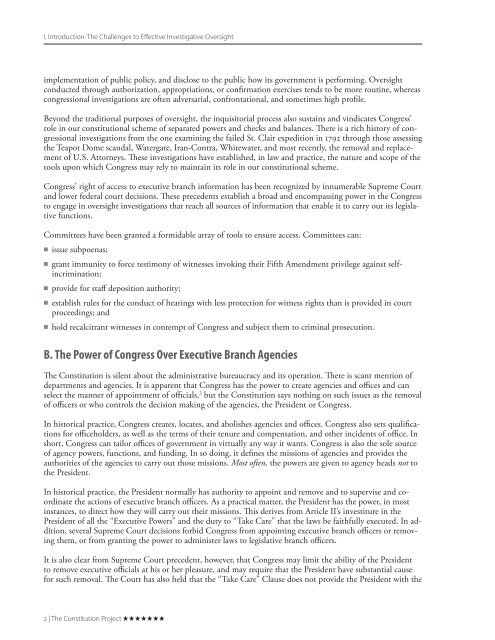When Congress Comes Calling
WhenCongressComesCalling
WhenCongressComesCalling
Create successful ePaper yourself
Turn your PDF publications into a flip-book with our unique Google optimized e-Paper software.
I. Introduction: The Challenges to Effective Investigative Oversight<br />
implementation of public policy, and disclose to the public how its government is performing. Oversight<br />
conducted through authorization, appropriations, or confirmation exercises tends to be more routine, whereas<br />
congressional investigations are often adversarial, confrontational, and sometimes high profile.<br />
Beyond the traditional purposes of oversight, the inquisitorial process also sustains and vindicates <strong>Congress</strong>’<br />
role in our constitutional scheme of separated powers and checks and balances. There is a rich history of congressional<br />
investigations from the one examining the failed St. Clair expedition in 1792 through those assessing<br />
the Teapot Dome scandal, Watergate, Iran-Contra, Whitewater, and most recently, the removal and replacement<br />
of U.S. Attorneys. These investigations have established, in law and practice, the nature and scope of the<br />
tools upon which <strong>Congress</strong> may rely to maintain its role in our constitutional scheme.<br />
<strong>Congress</strong>’ right of access to executive branch information has been recognized by innumerable Supreme Court<br />
and lower federal court decisions. These precedents establish a broad and encompassing power in the <strong>Congress</strong><br />
to engage in oversight investigations that reach all sources of information that enable it to carry out its legislative<br />
functions.<br />
Committees have been granted a formidable array of tools to ensure access. Committees can:<br />
33 issue subpoenas;<br />
33 grant immunity to force testimony of witnesses invoking their Fifth Amendment privilege against selfincrimination;<br />
33 provide for staff deposition authority;<br />
33 establish rules for the conduct of hearings with less protection for witness rights than is provided in court<br />
proceedings; and<br />
33 hold recalcitrant witnesses in contempt of <strong>Congress</strong> and subject them to criminal prosecution.<br />
B. The Power of <strong>Congress</strong> Over Executive Branch Agencies<br />
The Constitution is silent about the administrative bureaucracy and its operation. There is scant mention of<br />
departments and agencies. It is apparent that <strong>Congress</strong> has the power to create agencies and offices and can<br />
select the manner of appointment of officials, 2 but the Constitution says nothing on such issues as the removal<br />
of officers or who controls the decision making of the agencies, the President or <strong>Congress</strong>.<br />
In historical practice, <strong>Congress</strong> creates, locates, and abolishes agencies and offices. <strong>Congress</strong> also sets qualifications<br />
for officeholders, as well as the terms of their tenure and compensation, and other incidents of office. In<br />
short, <strong>Congress</strong> can tailor offices of government in virtually any way it wants. <strong>Congress</strong> is also the sole source<br />
of agency powers, functions, and funding. In so doing, it defines the missions of agencies and provides the<br />
authorities of the agencies to carry out those missions. Most often, the powers are given to agency heads not to<br />
the President.<br />
In historical practice, the President normally has authority to appoint and remove and to supervise and coordinate<br />
the actions of executive branch officers. As a practical matter, the President has the power, in most<br />
instances, to direct how they will carry out their missions. This derives from Article II’s investiture in the<br />
President of all the “Executive Powers” and the duty to “Take Care” that the laws be faithfully executed. In addition,<br />
several Supreme Court decisions forbid <strong>Congress</strong> from appointing executive branch officers or removing<br />
them, or from granting the power to administer laws to legislative branch officers.<br />
It is also clear from Supreme Court precedent, however, that <strong>Congress</strong> may limit the ability of the President<br />
to remove executive officials at his or her pleasure, and may require that the President have substantial cause<br />
for such removal. The Court has also held that the “Take Care” Clause does not provide the President with the<br />
2 | The Constitution Project


